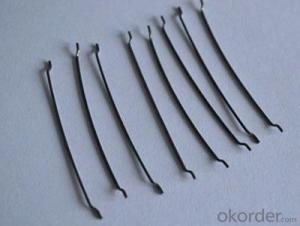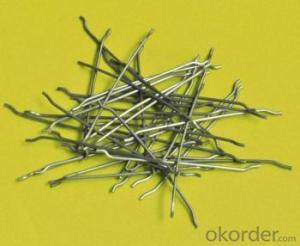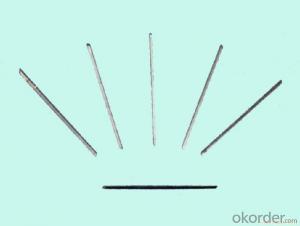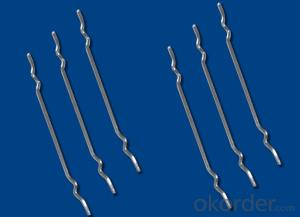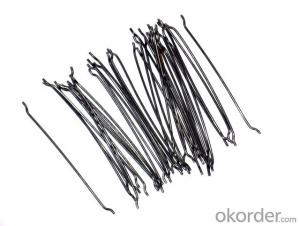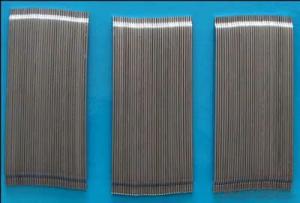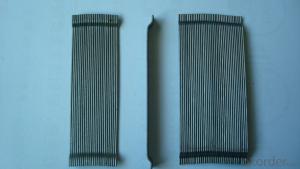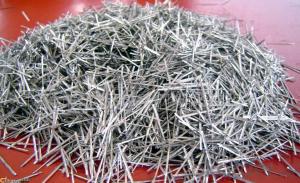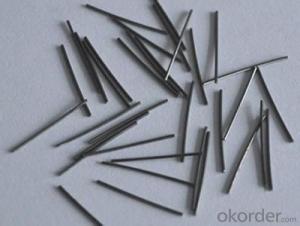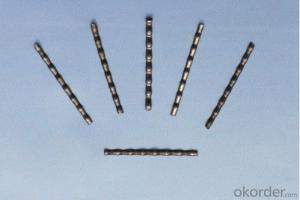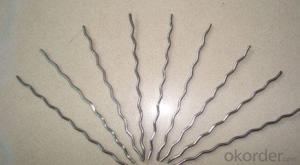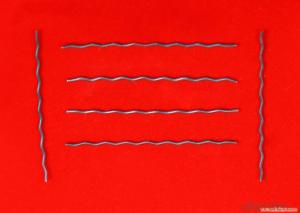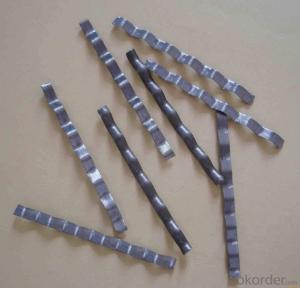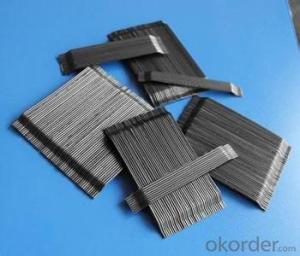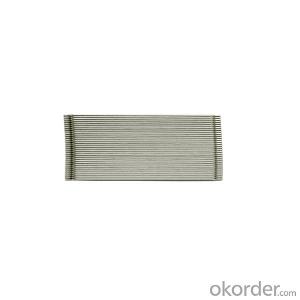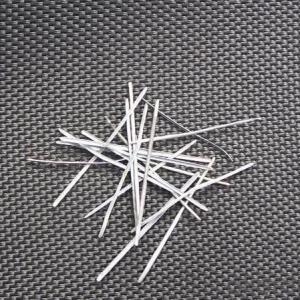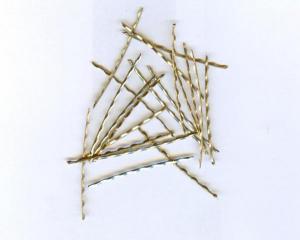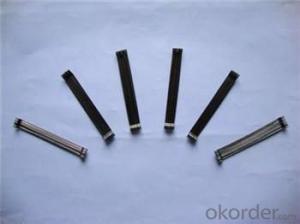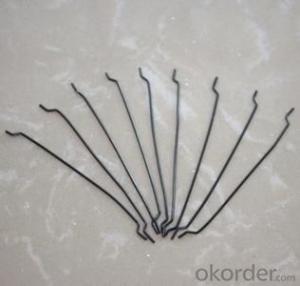Melt Extract Stainless Steel Fiber Reinforced Concrete Admixtures
- Loading Port:
- Tianjin
- Payment Terms:
- TT OR LC
- Min Order Qty:
- 2000 kg
- Supply Capability:
- 250000 kg/month
OKorder Service Pledge
OKorder Financial Service
You Might Also Like
Quick Details
Place of Origin: Shandong, China (Mainland)
- Model Number: steel fiber
material: steel wire
application: concrete reinocement
type: end hook steel fiber
Product features
with excellent tensile ,hightenacity ,against cracking and fatigue ,they`re widely usd in the structures made of concrete
Specifications
1.hooked steel fiber
2.CE and ISO9001:2008
3.diameter from 0.5mm to 1.2mm
4.competitive price,high quality and service
Hooked Steel Fiber:
1.Diameter:0.5mm-1.0mm
2.Length: 25mm-60mm
3.Material: low carbon steel wire
4.Feature: excellent tensile,high tenacity,against cracking,impact and fatigue
5.Uses: high way,tunnel,building,airport road serface and so on .
Picture

steel fiber concrete reinforced
FAQ
we can produce any type steel fiber and of course we can make production according to your requirement
we have specilize in this field for almost 10 years ,with good quality and competitive price
- Q: Can melt extract stainless steel fiber be used in thin concrete sections?
- Indeed, it is possible to employ melt extract stainless steel fiber in thin concrete sections. By incorporating stainless steel fibers into such sections, the mechanical properties and overall performance of the concrete can be significantly improved. These fibers effectively reinforce the concrete, bolstering its resistance to cracking and shrinkage. This becomes particularly crucial in thin sections, where the concrete is more susceptible to these concerns. Furthermore, the presence of stainless steel fibers enhances the durability and lifespan of the concrete, rendering it suitable for diverse applications, including thin sections.
- Q: Can melt extract stainless steel fiber be used in hydraulic structure construction?
- Yes, melt extract stainless steel fiber can be used in hydraulic structure construction. Stainless steel fiber provides enhanced durability and corrosion resistance, making it suitable for use in hydraulic structures that are exposed to water and other corrosive elements. It can be used in various applications such as slabs, tunnel linings, and foundations to improve the structural strength and crack resistance. Additionally, stainless steel fiber can also enhance the ductility and toughness of the concrete, resulting in improved resistance to impact and seismic forces. Therefore, melt extract stainless steel fiber is a viable option for reinforcing hydraulic structures and ensuring their long-term stability and performance.
- Q: Does melt extract stainless steel fiber enhance the impact resistance of concrete slabs?
- Yes, melt extract stainless steel fiber does enhance the impact resistance of concrete slabs. Stainless steel fibers are added to concrete mixtures to improve its mechanical properties, including impact resistance. These fibers are typically distributed evenly throughout the concrete mixture, providing reinforcement and preventing the formation of cracks. When an impact occurs, the stainless steel fibers help to distribute the stress and energy, reducing the likelihood of damage or failure. This enhanced impact resistance is particularly important in applications where the concrete slabs are exposed to heavy loads, such as industrial floors, bridge decks, and pavements. Overall, incorporating melt extract stainless steel fiber in concrete can significantly enhance its ability to withstand impact forces, improving the overall durability and longevity of the concrete slabs.
- Q: What are the requirements for storage and handling of melt extract stainless steel fiber?
- To maintain the integrity and quality of melt extract stainless steel fiber, several key factors must be considered: 1. Temperature: Ensure the storage area maintains a moderate temperature to prevent any adverse effects on the fiber. Extreme temperatures can alter its properties and impact performance. 2. Humidity: Store the fiber in a dry environment to prevent moisture absorption. Moisture can lead to corrosion and weaken the fiber, reducing its effectiveness. 3. Packaging: Keep the fiber in its original packaging or airtight containers to avoid exposure to air, dust, and contaminants. This preserves cleanliness and quality. 4. Handling: When handling the fiber, use appropriate protective equipment like gloves and safety glasses to prevent injuries. Its sharp edges require caution to avoid cuts or abrasions. 5. Avoid contact with other metals: Store the stainless steel fiber separately from other metals, especially those prone to corrosion. Contact with other metals can cause galvanic corrosion, degrading performance. 6. Proper labeling and identification: Ensure the melt extract stainless steel fiber is correctly labeled and identified for traceability and to avoid confusion with other materials. This assists in maintaining quality control and efficient inventory management. Following these storage and handling requirements preserves the melt extract stainless steel fiber's optimal condition, ensuring reliability and longevity in applications such as concrete reinforcement, thermal insulation, and electrical conductivity.
- Q: What is the effect of melt extract stainless steel fiber on the flexural toughness of concrete?
- The flexural toughness of concrete is significantly influenced by the incorporation of melt extract stainless steel fiber. Known for their high tensile strength and ductility, stainless steel fibers play a crucial role in enhancing the flexural toughness of concrete. By adding stainless steel fibers to concrete, the material gains reinforcement and increased strength. These fibers are evenly dispersed throughout the concrete matrix, creating a three-dimensional network that effectively resists cracks and distributes the applied load more efficiently. Additionally, the melt extract stainless steel fibers contribute to the post-cracking behavior of concrete. When subjected to a load, these fibers act as bridges across any cracks that may form, effectively transferring stress and preventing further propagation of cracks. This bridge-like effect enhances the ductility and energy absorption capacity of concrete, thereby improving its flexural toughness. Numerous studies have demonstrated that the inclusion of melt extract stainless steel fibers can significantly enhance the flexural toughness of concrete, resulting in improved resistance against bending and impact forces. This is particularly advantageous in structural applications where concrete is exposed to dynamic loads or where enhanced durability and crack resistance are desired. In summary, the inclusion of melt extract stainless steel fiber in concrete positively impacts its flexural toughness through reinforcement, improved post-cracking behavior, and increased resistance to bending and impact forces.
- Q: How does melt extract stainless steel fiber enhance the resistance to impact loads in concrete?
- Melt extract stainless steel fiber enhances the resistance to impact loads in concrete through its unique properties and behavior. When added to concrete, stainless steel fibers disperse uniformly throughout the mixture, creating a three-dimensional reinforcement network. This network acts as a secondary reinforcement system, increasing the concrete's ability to resist impact loads. The high tensile strength and ductility of stainless steel fibers play a crucial role in enhancing impact resistance. Unlike traditional reinforcement materials like steel bars or mesh, stainless steel fibers have a much higher tensile strength, enabling them to distribute the impact energy more effectively. This prevents the formation of cracks and improves the overall durability of the concrete. Additionally, stainless steel fibers have excellent bonding characteristics with the concrete matrix. This strong bond ensures that the fibers remain in place even under heavy impact loads, effectively transferring the load from the surface of the concrete to the fiber reinforcement system. This mechanism helps to dissipate the impact energy and reduce the risk of surface spalling or cracking. Furthermore, the unique aspect of melt extract stainless steel fibers lies in their ability to withstand elevated temperatures. This is particularly important in situations where impact loads may be accompanied by high temperatures, such as fire incidents or explosions. The stainless steel fibers can maintain their structural integrity even at high temperatures, providing continuous reinforcement to the concrete and enhancing its resistance to impact under extreme conditions. In summary, melt extract stainless steel fiber enhances the resistance to impact loads in concrete by creating a strong and uniform reinforcement network. Its high tensile strength, excellent bonding characteristics, and ability to withstand elevated temperatures contribute to the overall durability and impact resistance of the concrete.
- Q: What are the different shapes and sizes of melt extract stainless steel fiber available?
- There are various shapes and sizes of melt extract stainless steel fiber available, including round, flat, and crimped shapes. The sizes range from micron-scale fibers to larger sizes, depending on the specific application and requirement.
- Q: How does melt extract stainless steel fiber enhance the resistance of concrete to dynamic loading?
- Melt extract stainless steel fiber is a reinforcement material that is added to concrete to enhance its resistance to dynamic loading. This type of fiber is produced by melting stainless steel and then rapidly extracting it in a molten state to create fine, solid fibers. When these stainless steel fibers are incorporated into concrete, they act as a distributed reinforcement system throughout the entire volume of the material. This reinforcement helps to improve the overall mechanical properties of the concrete, specifically its resistance to dynamic loading. Dynamic loading refers to the application of fluctuating or cyclic loads on a structure, which can result in fatigue and failure over time. The addition of melt extract stainless steel fibers helps to mitigate these effects by providing additional strength and toughness to the concrete. The fibers act as tiny reinforcements that distribute the applied load more evenly across the concrete matrix. This reduces the concentration of stress points and prevents the formation of cracks and fractures that can occur under dynamic loading conditions. Furthermore, the high tensile strength and ductility of stainless steel fibers allow them to absorb and dissipate energy during dynamic loading. This energy absorption capability helps to minimize the transfer of stress to the surrounding concrete, thereby reducing the likelihood of structural failure. In addition to enhancing resistance to dynamic loading, melt extract stainless steel fibers also improve other aspects of concrete performance. They enhance the material's flexural and tensile strength, impact resistance, and durability. This makes the concrete more resilient and able to withstand the rigors of dynamic loading over its service life. Overall, the incorporation of melt extract stainless steel fiber in concrete significantly enhances its resistance to dynamic loading by improving its strength, toughness, and energy absorption capabilities. This leads to a more durable and reliable concrete structure that can withstand the demands of dynamic loading without experiencing premature failure.
- Q: Can melt extract stainless steel fiber be used in tunnel segmental lining?
- Yes, melt extract stainless steel fiber can be used in tunnel segmental lining. This type of stainless steel fiber offers excellent durability, enhanced crack resistance, and improved structural integrity, making it an ideal choice for reinforcing tunnel segmental linings.
- Q: How does melt extract stainless steel fiber affect the curing time of concrete?
- The curing time of concrete can be influenced both positively and negatively by the use of melt extract stainless steel fiber. Incorporating stainless steel fibers into concrete can enhance its early age strength development, resulting in a quicker curing process. These fibers act as reinforcement, improving the overall mechanical properties of the concrete and reducing drying shrinkage. Additionally, stainless steel fibers can enhance the durability and resistance to cracks in concrete, leading to a faster curing time. By preventing cracks and reducing the need for repairs or maintenance, the concrete can cure more efficiently. However, the addition of stainless steel fibers can also lengthen the curing time of concrete. This is because the fibers may impede the movement of water within the concrete mixture, slowing down the hydration process. Moreover, the presence of fibers can increase the viscosity of the concrete, making it more challenging for moisture to penetrate and fully hydrate the cement particles. Ultimately, the impact of melt extract stainless steel fiber on the curing time of concrete relies on various factors like the amount of fiber used, aspect ratio, and mix design. It is crucial to carefully consider these factors and conduct thorough testing to determine the optimal dosage and type of fiber to achieve the desired curing time in concrete applications.
Send your message to us
Melt Extract Stainless Steel Fiber Reinforced Concrete Admixtures
- Loading Port:
- Tianjin
- Payment Terms:
- TT OR LC
- Min Order Qty:
- 2000 kg
- Supply Capability:
- 250000 kg/month
OKorder Service Pledge
OKorder Financial Service
Similar products
Hot products
Hot Searches
Related keywords
